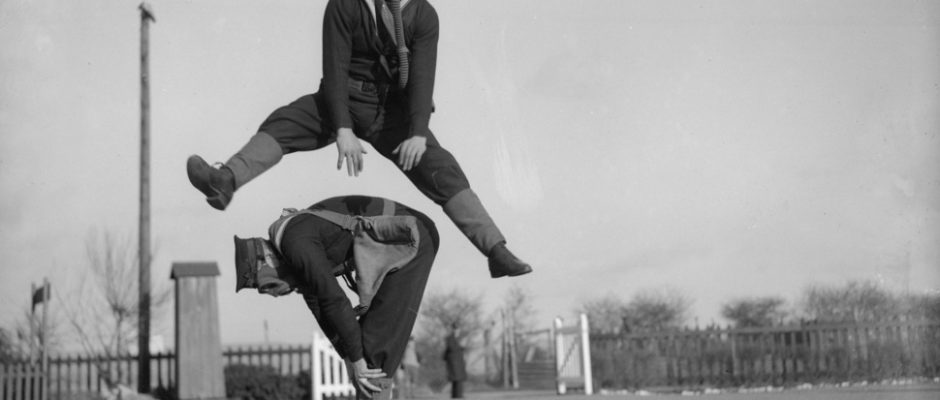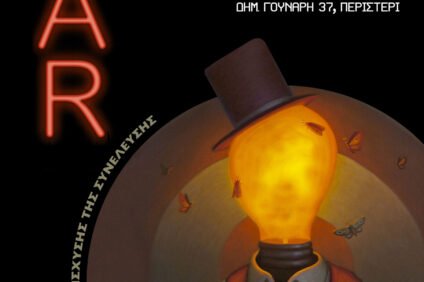An Illustrated History Of Gas Masks
The gas mask has a history that dates back thousands of years, though it wasn’t until World War I that it became nightmare fodder for Doctor Who and countless other stories. Here is a sometimes terrifying history of the gas mask, from its beginnings through the present day.
Playing leapfrog, 1934
Above. Able seamen at the Royal Navy Anti-Gas School at Tipnor, Portsmouth play leapfrog wearing gas masks, to accustom them to carrying out strenuous tasks in respirators, on January 22 1934.
(Photo by William Vanderson/Fox Photos/Getty Images)
The common sponge, ancient Greece

According to the Popular Mechanics (January 1984):
“The common sponge was used in ancient Greece as a gas mask, a compress, a contraceptive – and, of course, for bathing.”
(via Wikimedia Commons/Tom Oates)
Banū Mūsā Gas Mask, c. 850 A.D

This gas mask was designed by the Banu Musa brothers in Baghdad, Iraq to protect workers working in polluted wells. The device was mentioned in the brothers book “Book of Ingenious Devices” that describes 100 inventions.
(Illustrations are from the brothers’ book, but not about the gas mask, via Wikimedia Commons 1 – 2)
Plague Doctor’s Mask
 Expand
Expand
The bird-like beak mask was often filled with sweet or strong smelling herbs or spices – lavender, mint, camphor or dried roses. They’ve believed it would banish the evil smells.
 Expand
Expand
(via Wikimedia Commons/Traité de la peste, 1721 and etsy/Tom Banwell)
Alexander von Humboldt’s mask, 1799

It was the first device with respirator, invented for miners by a Prussian mining official Alexander von Humboldt.
(via Asher Rare Books)
A smoke protecting apparatus for firemen by John and Charles Deane, 1823
 Expand
Expand
In the early 1820s John Deane have seen a burning stable with trapped horses in it. To get through the smoke and rescue all the horses he put on an old knight-in-armor helmet air-pumped by a hose from a fire brigade water pump. The saving was successful, and in 1823 John and Charles Deane have invented the Smoke Helmet:
“An apparatus or machine to be worn by persons entering rooms or other places filled with smoke or other vapour, for the purpose of extinguishing fire or extricating persons or property therein.”
The device was a single copper helmet with a long leather hose attached to the rear. A long leather hose was attached to the rear. Five years later it was converted for underwater use.
(via Submerged)
Lewis Haslett: “Inhaler or Lung Protector”, 1847, patented in 1849
 Expand
Expand
It allowed breathing through a nose or mouthpiece fitted with two one-way clapper walves. The filter was made of wool or other porous substances with water could keeping out dust.
(via Google Patent Search)
The charcoal air-filter of John Stenhouse, 1854 (patented in 1860 and 1867)
In the copper-framed mask there was powdered wood charcoal between the two hemispheres. The charcoal could be replaced through a small door in the wire gauze.
(via Wikimedia Commons)
John Tyndall’s respirator, 1871
 Expand
Expand
The Irish physicist took Stenhouse’s mask and added a filter of cotton wool saturated with charcoal, lime and glycerin. The new device has filtered smoke and some noxious gases from air.
(via Wikimedia Commons and steampunksp)
Samuel Barton’s respirators, 1874
 Expand
Expand
This respirator had rubber-and-metal face cover, glass eyepieces, rubber-coated hood and a metal canister on the front of the mask contained lime, glycerin-soaked cotton wool and charcoal.
(via Google Patent Search/148868)
Smoke-Excluding Mask, George Neally, 1877 and 1879

 Expand
Expand
The first version had a filter carried on the chest, but two years later he patented another version with the filter mounted directly on the facepiece.
(via Google Patent Search – 1 and 2)
Fleuss Apparatus, 1878

The rubberized mask covered the whole face was connected via tubes to a breathing bag.
(via History of Diving Museum)
Vajen-Bader Smoke Protector

The Indianapolis-based company produced smoke protectors from 1881.
(via Fire Museum Network)
Loeb’s Respirator, 1891
 Expand
Expand
The German Bernhard Loeb’s protective equipment had a triple-chambered metal canister that was attached directly to the closed helmet.
(via Google Patent Search/533854)
Muntz Respirator, 1902
The proper duckface from the first years of the 20th century is a full head-covering mask with a sponge- and a carbon-based filter.
(via Google Patent Search/703948)
Safety Hood and Smoke Protector, Garret A. Morgan, 1912, patented in 1914.
 Expand
Expand
This device had a cotton hood with two hoses which hung down the floor, allowing the wearer to breath the air found there.
 Expand
Expand
In 1916 he won an acclaim for his device after they’ve used the device to rescue some men from the gas- and smoke-filled tunnels beneath Lake Erie in the Cleveland Waterworks.
(via Google Patent Search – 1 and 2)
The British Army Black Veil Respirator

After the first gas attack ever near Ypres in Belgium (22 April 1915), some Allies were dead because of the chlorine gas. The British reaction was really quick: they’ve made some respirators from cotton mouth pads with a long cloth. The pads provided no protection when dry, so the Black Veil could work for about five minutes against a normal concentration of chlorine.
(via Australian War Memorial)
A German soldier from the WWI
 Expand
Expand
(via Old Photos)
Hypo helmet or British Smoke Hood, 1915
 Expand
Expand
Constructed by Dr. Cluny MacPherson of Royal Newfoundland Regiment after he saw a German putting a bag over his head after a gas attack.
 Expand
Expand
The Hypo helmet contained glycerin and sodium thiosulphate that protected against chlorine. Two and a half million had been made.
(via Gunboards and Wikimedia Commons/Imperial War Museums)
GM-15 (Gummimaske-15) from Germany, WWI
 Expand
Expand
 Expand
Expand
(via Gasmasklexikon, Wikimedia Commons/German Federal Archive)
Three workers demonstrating the different types of gas masks used in mine rescue work, 1925
 Expand
Expand
(Photo by Fox Photos/Getty Images)
Dustbowl masks, c. 1935
 Expand
Expand
Three girls modelling various dustbowl masks to be worn in areas where the amount of dust in the air causes breathing difficulties, circa 1935.
(Photo by Bert Garai/Keystone/Hulton Archive/Getty Images)
Finnish civilian gas mask from 1939
 Expand
Expand
(via Wikimedia Commons)
Gas Protection, 1941
 Expand
Expand
Three air raid wardens wearing a new type of gas mask, designed for the elderly and those with chest complaints, during a mock gas attack in which tear gas was released in Esher High Street on 5th April 1941.
(Photo by A. Hudson/Topical Press Agency/Getty Images)
Mickey Mouse Gas Mask, 1942

Thes gas masks were produced by the Sun Rubber Products Company from early 1942, with Walt Disney’s approval to protect children in case of an American chemical attack.

(via colordonor and terrapapers)
Gas Mask Wedding on Miyakejima, Izu Islands, Japan
 Expand
Expand
The land is atop an active volcanic chain that has erupted six times in the 20th Century. In 2000, all of the islands residents were evacuated, but in 2005 they were allowed to return permanently but were required to carry gas masks.
(via imgur)
Slicing onions

(via emorfes)
A Member Of The U.S. Air Force 51St Security Forces Squadron Talks On The Radio Through His Chemical/Biological Protective Mask, January 6, 1999
 Expand
Expand
(Photo By Usaf/Getty Images)
(The main picture of the post is from 1917, Hulton Archive/Getty Images)
*αναδημοσίευση από http://io9.com/an-illustrated-history-of-gas-masks-504296785








Leave a Reply